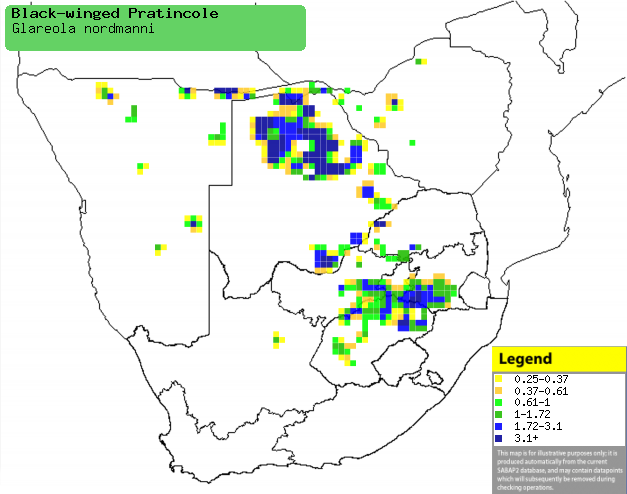|
Glareola nordmanni (Black-winged
pratincole)
Swartvlerksprinkaanvoël [Afrikaans]; Lehlakangoato [South
Sotho]; Steppevorkstaartplevier [Dutch]; Glaréole à ailes noires [French];
Schwarzflügel-brachschwalbe [German]; Perdiz-do-mar-d'asa-preta [Portuguese]
Life
> Eukaryotes >
Opisthokonta
> Metazoa (animals) >
Bilateria >
Deuterostomia > Chordata >
Craniata > Vertebrata (vertebrates) > Gnathostomata (jawed
vertebrates) > Teleostomi (teleost fish) > Osteichthyes (bony fish) > Class:
Sarcopterygii (lobe-finned
fish) > Stegocephalia (terrestrial
vertebrates) > Tetrapoda
(four-legged vertebrates) > Reptiliomorpha > Amniota >
Reptilia (reptiles) >
Romeriida > Diapsida > Archosauromorpha > Archosauria >
Dinosauria
(dinosaurs) > Saurischia > Theropoda (bipedal predatory dinosaurs) >
Coelurosauria > Maniraptora > Aves
(birds) >
Order: Charadriiformes > Family: Glareolidae
Distribution and habitat
Breeds from northern Black Sea to eastern Kazakhstan,
heading south in the non-breeding season to a narrow band of sub-Saharan Africa,
from eastern Sudan and western Ethiopia south through eastern DRC, Uganda,
western Zambia and eastern Angola to southern Africa. Within southern Africa it
is uncommon in north-eastern Namibia, northern and south-eastern Botswana,
western Zimbabwe and east-central South Africa. It generally prefers open seasonally wet
grassland, edges of pans and cultivated land.
|
 |
|
Distribution of Black-winged pratincole in southern Africa,
based on statistical smoothing of the records from first SA Bird Atlas
Project (©
Animal Demography unit, University of
Cape Town; smoothing by Birgit Erni and Francesca Little). Colours range
from dark blue (most common) through to yellow (least common).
See here for the latest distribution
from the SABAP2. |
Movements and migrations
Leaves its breeding grounds from
August-October, moving over land and eventually reaching southern
Africa in November, before departing in March.
Food
It mainly eats insects, doing most of its foraging in the
early morning and evening, hawking insects aerially and running in short dashes
on the ground to catch prey. The following food items have been recorded
in its diet:
Threats
Status uncertain globally, but Near-threatened in
southern Africa, where it has been increasingly scarce, thought to have been
caused by habitat destruction at its Eurasian breeding grounds.
References
-
Hockey PAR, Dean WRJ and Ryan PG 2005. Roberts
- Birds of southern Africa, VIIth ed. The Trustees of the John Voelcker
Bird Book Fund, Cape Town.
|
